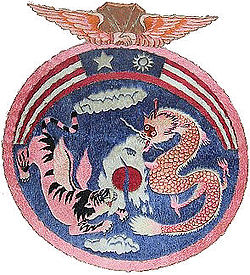- Chinese-American Composite Wing (Provisional)
-
Chinese-American Composite Wing (Provisional) 
Emblem of the CACWActive 1943-1943 Branch United States Army Air Force
Republic of China Air ForceThe Chinese-American Composite Wing (Provisional) was a joint United States Army Air Force and a Republic of China Air Force organization. It was administratively assigned to Fourteenth Air Force in China during World War II.
The operational units of the Chinese-American Composite Wing CACW were jointly commanded by both American and Chinese air force officers, and the unit's aircraft were manned by American and Chinese pilots and air crewmen.
Today, the 1st, 3rd and 5th Groups of CACW are still operating in Taiwan, reorganized as 443rd, 427th and 401st Tactical Fighter Wings of the Republic of China Air Force.
Contents
History
Lineage
- Initially formed on 31 July 1943 as the 1st Bomb Group (Provisional) and the 3rd Fighter Group (Provisional), Republic of China Air Force
- Established as: Chinese American Composite Wing (Provisional), USAAF, and activated on 1 October 1943
- Inactivated on 1 August 1945
Assignments
- USAAF Fourteenth Air Force, 1 October 1943-1 August 1945
Components
- 1st Bombardment Gp (Provisional)
- 1st Bombardment Sq (Provisional)
- 2nd Bombardment Sq (Provisional)
- 3d Bombardment Sq (Provisional)
- 4th Bombardment Sq (Provisional)
- 3d Fighter Gp (Provisional)
- 7th Fighter Sq (Provisional)
- 8th Fighter Sq (Provisional)
- 28th Fighter Sq (Provisional)
- 32nd Fighter Sq (Provisional)
- 5th Fighter Gp (Provisional)
- 17th Fighter Sq (Provisional)
- 26th Fighter Sq (Provisional)
- 27th Fighter Sq (Provisional)
- 29th Fighter Sq (Provisional)
Aircraft
- P-40 Warhawk, 1943–1945
- P-51 Mustang, 1944–1945
- B-25 Mitchell, 1943–1945
Stations
Most CACW bases existed near the boundary of Japanese-Occupied China, and one "Valley Field" existed in an area within Japanese-held territory. Specific field locations include Hanchung, Ankang, Hsian, Laohokow, Enshih, Liangshan, Peishyi, Chihkiang, Hengyang, Kweilin, Liuchow, Chanyi, Suichwan, and Lingling
Operations history
Aircraft assigned to the CACW included late-model P-40 Warhawks (with the Nationalist Chinese Air Force 12-pointed star national insignia, rudder markings and squadron/aircraft numbering) and B-25 "Mitchell" medium bombers. The Mitchells included the standard B-25D, the B-25H (equipped with a 75-millimeter cannon in the nose), and the B-25J. Like the CACW's fighters, most B-25's bore the Nationalist Chinese star insignia on the wings and fuselage. In late 1944, USAAF-marked P-51 Mustangs began to be assigned to CACW pilots – first, P-51B and C models, then, in early 1945, "D" and "K" model (sharing many of the external characteristics of the "D" model aircraft including the bubble canopy) reduced-weight versions. All U.S. pilots assigned to the CACW were listed as rated pilots in Chinese Air Force, and were authorized to wearing both nations' pilot's wings.
During its year and a half of operations, the Chinese and American airmen of the CACW could claim the destruction of 190 Japanese aircraft in air-to-air combat, and 301 more on the ground. The fighters and bombers of the CACW had destroyed at least 1500 Japanese vehicles and sunk several hundred thousand tons of Japanese merchant and naval shipping, in addition they had taken a heavy toll on Japanese ground troops, facilities, railroads and bridges. In that same time, they had lost 35 fighters and 8 bombers to enemy ground fire, and 20 fighters to Japanese aircraft. However, not a single CACW bomber had been lost to enemy fighters, a tribute to the abilities of the Wing's B-25 aircrews, and the quality of the escort protection provided by the Wing's fighter pilots.
The most successful fighter pilot of the CACW was Lt. Colonel William N. Reed, who had first fought in China as a member of the AVG. As a "Flying Tiger," Reed had destroyed 3 Japanese aircraft in aerial combat and 8 more on the ground. Then returning to China to command the CACW's 7th Fighter Squadron and eventually its 3d Fighter Group, he would destroy an additional 6 Japanese aircraft in aerial combat. According to the book "China Bombers" by Ken Daniels, Reed was killed while parachuting from a disabled P-40 on December 19, 1944.
References
 This article incorporates public domain material from websites or documents of the Air Force Historical Research Agency.
This article incorporates public domain material from websites or documents of the Air Force Historical Research Agency.External links
 USAAF Fourteenth Air Force in World War II
USAAF Fourteenth Air Force in World War IIPreviously: 1st American Volunteer Group (AVG) "Flying Tigers" (Dec 1941-July 1942) China Air Task Force (July 1942-Mar 1943) Airfields China Ankang · Chanyi · Chengkung · Chengtu · Chihkiang · Hanchung · Hankow · Hsian · Hsingching · Huhsien · Kanchow · Kiangwan · Kunming · Kwanghan · Kweilin · Laifeng · Laohwangping · Loping · Liangshan · Liuchow · Luliang · Nanning · Peishiyi · Pungchacheng · Shwangliu · Suichwan · Tsuyung · Yangkai · Yunnani
Units Wings Groups Bombardment 308th Bombardment · 341st Bombardment · 402d BombardmentFighter 23d Fighter · 33d Fighter · 51st Fighter · 81st Fighter · 311th Fighter · 476th FighterTransport 443d Troop CarrierSquadrons Combat Cargo Night Fighter 426th Night Fighter · 427th Night FighterReconnaissance 21st Photographic Reconnaissance · 35th Photographic ReconnaissanceTransport 322d Troop CarrierUnited States Army Air Forces
First · Second · Third · Fourth · Fifth · Sixth · Seventh · Eighth · Ninth · Tenth · Eleventh · Twelfth · Thirteenth · Fourteenth · Fifteenth · TwentiethCategories:
Wikimedia Foundation. 2010.
